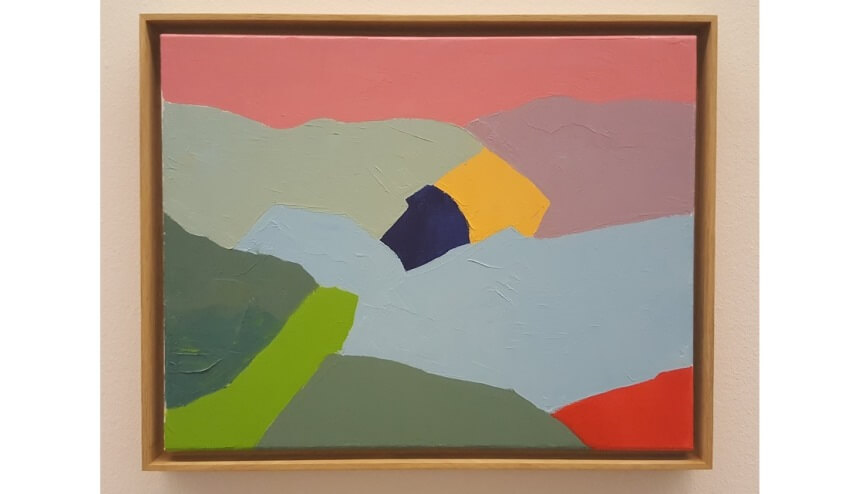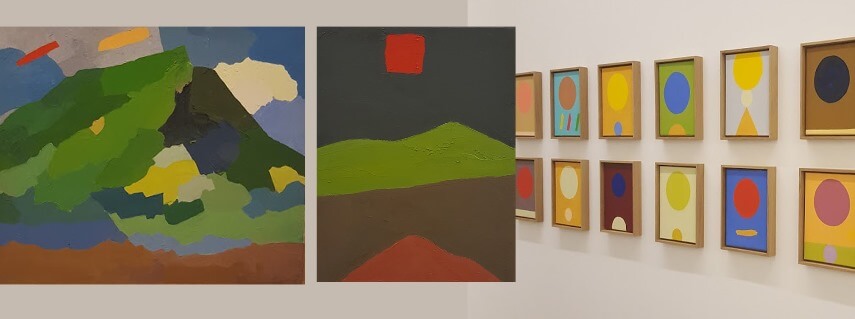
Etel Adnan and the Poetry of Her Abstract Landscapes
Something about the paintings of Etel Adnan and those of Agnes Martin feels similar. It has nothing to do with appearance, for the two artists’ work looks almost nothing alike. Rather it has to do with their effect. Martin often spoke of her desire to impart a feeling of happiness through her work. That’s the source of the similarity between these two artists. Etel Adnan’s abstract paintings lift invisible burdens. They transform whatever room they’re in, making it somehow lighter, more calming, more like home. That’s not to say that Adnan’s work is merely decorative. Quite the contrary, her diverse and prolific oeuvre conveys profundity and depth. It is just to say that something about the aesthetic language Adnan has created over the course of her 91 years of life temporarily makes the world seem less complicated. It offers those lucky enough to be in its presence a chance to catch a breath, to think about what is truly important, or to simply be.
Visual Poetry
Looking at the paintings Etel Adnan is making today in her 90s, a viewer could easily mistake them as the products of someone who has had a calm and simple life. But Adnan’s life has been anything but simple. Multi-lingual and multi-cultural, she is a true citizen of the world. She was born in 1925 in Lebanon, just five years into that country’s existence, while it was still a French colony and a year before it had a constitution. She studied in French-speaking schools. Her mother was Greek and her father was Syrian. They spoke Turkish at home. After the Second World War ended, she moved to Paris and studied philosophy at the Sorbonne. Then it was on to America, to Berkeley and Harvard for graduate studies.
Adnan’s personal connections to so many languages, cultures and nations have found expression in a multitude of ways in her creative life. She has been writing poetry in multiple languages since the age of 20. She has made films, published books, created textiles and mastered the art of leporellos, Japanese-inspired folding books containing both poetry and art. And now, after a lifetime of relatively undiscovered brilliance, it is her paintings that have brought her international acclaim.
Etel Adnan’s Language of Abstraction
Adnan began painting in 1960 while living and teaching in California. She had already developed a strong and unique writing voice through which she expressed in no uncertain terms her disgust with violence and war. Painting offered her a different kind of outlet for a new kind of expression. Through painting she found that she could offer an alternative vision of the world, one composed of color, harmony and balance. Her eloquent, abstract compositions suggest a place of calmness and safety, not as a place to hide from trouble, but in which to confront it through contemplation.
Many of the forms and compositions that appear in Adnan’s abstract paintings are informed by the visual landscape of the/blogs/magazine/famous-abstract-paintings-that-changed-the-way-we-perceive-arting human habitats offers a definite starting point for understanding Adnan’s imagery. But her intuitive ability to reduce that figurative world into something more universal gives way to a far more transcendent aesthetic language composed of color fields and geometric forms. Her abstractions are less related to external nature and more closely aligned with something internal.

Etel Adnan - Untitled, 2012, Oil on canvas. © Etel Adnan
The Weight of the World
Adnan’s oeuvre is currently the subject of a large retrospective at Serpentine Gallery at Kensington Gardens, London, which IdeelArt recently had the pleasure of visiting. Titled The Weight of the World, the exhibition features nearly 100 of Adnan’s works, including examples of her drawings, films, poetry, leporellos, large folding screens, textiles, and of course her paintings. Seeing the entirety of her output assembled thoughtfully in one space offers a rare glimpse into an artist who has spoken across a multitude of mediums across many decades in a clear, unified voice.
Adnan’s large folding screens and leporellos evoke an Eastern vision of abstraction, one less founded on history and academia and more directly connected to the natural symbolism of line, color and form. Also in that vein are some of her abstract watercolors from the 1960s. One untitled watercolor from 1964 stood out to us in particular as offering a vision that seems somehow outside of time and place. Its expressive brush marks convey energy and freedom. Circular red, green and yellow forms recall fundamental Modernist aesthetics. Subtle staining creates a sense of depth and weight, while calligraphic lines hint at some unknown, possible-ancient-possibly-futuristic alphabet. This piece could be read as a landscape or an abstraction. Either way it communicates harmony through the odd balance of the natural world.
Comparing a series of paintings on exhibit in the show reveals hints to the evolution of Adnan’s vision. An untitled canvas from 1983 is easily read as a mountain landscape. An untitled canvas from 2014 offers a simplified abstraction of a similar scene. A set of 20 identically sized paintings from 2016 titled Le poids du monde (the weight of the world) abstracts the forms from those earlier landscapes to their purest state, offering myriad tranquil expressions of their universal voice.

Etel AdnanUntitled, 1983 (left), Untitled, 2014 (center) and Le poids du monde (right). © Etel Adnan
The work on view in The Weight of the World allows the purity of Adnan’s expression to become so clear. She has never been shy about her opinions. She has seen suffering, violence and war, and detests it all. But rather than simply decry what is wrong, she offers through her paintings alternatives through a focus on what is universal. She creates beauty, balance and harmony, which help the weight of the world get lighter all the time.
Featured Image: Etel Adnan -Untitled, Watercolor on paper, 1964, 37.6 x 45.5 cm. © Etel Adnan
All images used for illustrative purposes only
By Phillip Barcio






